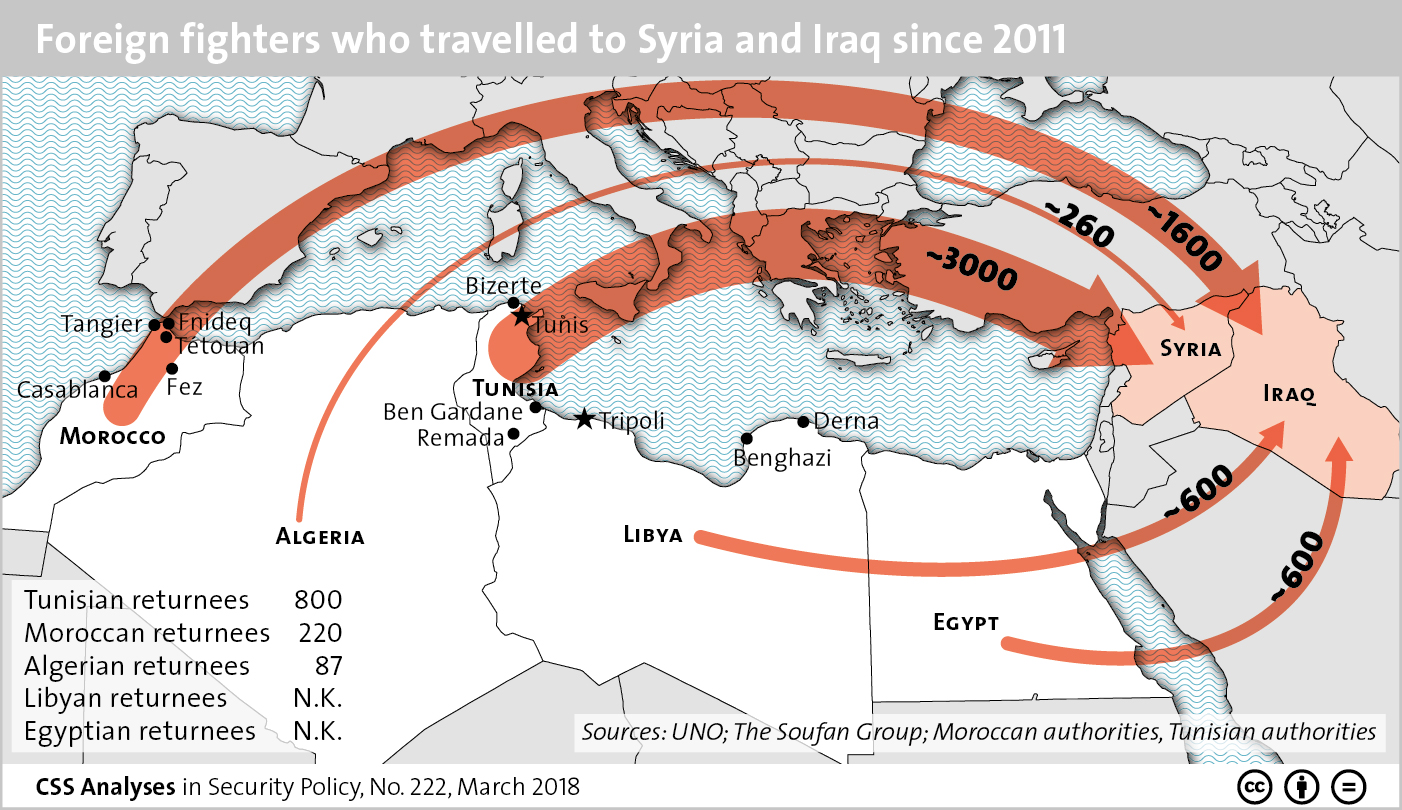The Military Academy at ETH Zurich and the Center for Security Studies at ETH Zurich have published the annual survey «Sicherheit 2018». Since 1999, the study has evaluated long-term trends and tendencies in public opinion on foreign, security and defense policy issues in Switzerland.
Tag: Security

This graphic traces both the numbers of foreign fighters who traveled to Syria and Iraq from North African countries, as well as those who have returned to their country of origin or residence since 2011. To find out more about North Africa’s foreign fighters, see Lisa Watanabe’s recent addition to our CSS Analyses in Security Policy series here. For more graphics on peace and conflict, see the CSS’ collection of graphs and charts on the subject here.

This article was originally published by the European Union Institute for Security Studies (EUISS) on 5 May 2017.
Until recently, Israeli-Palestinian security cooperation was seen as a unique ‘success story’ of the Middle East Peace Process. However, recent developments seem to be challenging this narrative; only last month, demonstrations attracted thousands of Palestinian protesters who demanded the suspension of cooperation with Israel. Shortly before this, Palestinian Authority (PA) President Mahmoud Abbas threatened to end Israeli-Palestinian security cooperation in response to a new Knesset law which retroactively legalised some 4,000 Israeli settler houses built on private Palestinian land. Consequently, one of the cornerstones of the Oslo Accords now appears to be under real threat.
Effective cooperation – what for?
Cooperation between Israel and the Palestinians in security terms has hitherto been robust in the West Bank (Hamas put an end to it in Gaza in 2007) and dates back to the 1993 Oslo Accords. These stipulated the creation of ‘a strong police force’ which would guarantee public order and internal security for Palestinians, while the Israeli state was to be responsible for countering external threats and ensuring the overall security of Israelis. Today, with over 44% of public sector employees in the PA working in the security sector (over 80,000 people), it remains a major provider of income to the Palestinian population. It also accounts for the lion’s share of the PA’s annual budget, with 30-45% allocated to this sector.

This article was originally published by the Harvard International Review (HIR) on 17 April 2017.
President Donald Trump has made no secret of his skepticism toward America’s most important security pacts and military commitments, sending shockwaves throughout East Asia in April when he suggested that Japan, among others, should pay more for American protection and arm themselves with nuclear weapons to deter North Korea. The Japanese government relies heavily upon its mutual defense treaty with the United States for its national security, as Article IX of the Japanese Constitution strictly limits the nation’s war-making capacity. Trump’s electoral victory in November thus has startling implications for the island nation, prompting some question as to whether Japan should start pursuing a more conventional military arrangement for its own self-defense. However, the prospect of a rapidly aging population and a dwindling labor force will serve as an obstacle to future military self-sufficiency.
The Imperative for an Expanded Military
Following Japan’s defeat in the Second World War, US-led occupation forces drafted a new constitution in which the nation relinquished its right to wage war. The United States subsequently signed a security treaty with Japan, permitting the United States to maintain permanent military bases on Japanese soil “to deter armed attack” against a pacified, and thus vulnerable, Japan. US authorities also encouraged Japan to maintain a limited self-defense force to guard against growing Communist elements in China and Korea. However, the Self-Defense Forces (SDF), now composed of roughly 247,000 active personnel, engage primarily in international peacekeeping and disaster relief.

This article was originally published by the Centre for European Policy Studies (CEPS) on 6 April 2017.
As a failed state in the European Union’s immediate neighbourhood that serves as a base camp for terrorists and a conduit for irregular migration to Europe, Libya is precisely the kind of place for which the EU’s foreign policy instruments were designed, or so one might think. Since the NATO intervention that helped oust Libyan dictator Muammar Gaddafi in 2011, the EU has deployed most of its crisis response approaches and instruments in the country, including new procedures set out in the 2013 review of the European External Action Service (EEAS), most notably a Political Framework for a Crisis Approach (PFCA).
Yet, almost nothing in Libya has followed the liberal peacebuilding playbook, which assumes an improving security situation followed by reconstruction and sustained democratic political transformation. Instead, the EU has struggled to make any impact while the ongoing chaos in the country has deepened divisions among member states, with migration control emerging as the lowest common denominator for EU action.




